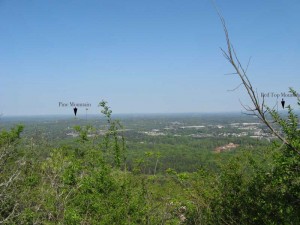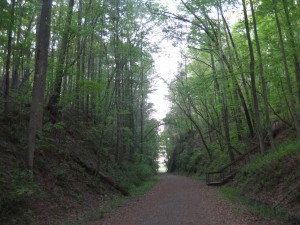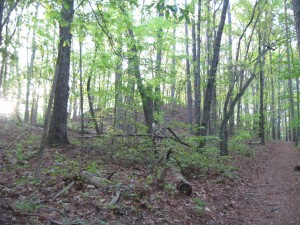Excuse the morbid curiosity exhibited in this post. I debated whether to post or not, and in the end, decided to do so.
Most days, I’ve taken the time to view the latest entry in the “Gettysburg Daily” blog. Recently Jerry Coates did a report on his assertion about where the “Harvest of Death” photos were taken, as William Frassanito could not find the location of these photo’s. I’m pretty well convinced by Jerry Coate’s argument, that the pictures are of the 5th New Jersey near the Spangler farm.
The image, can be found on the Library of Congress website. http://lcweb2.loc.gov/cgi-bin/query/r?ammem/cwar:@field(NUMBER+@band(ppmsc+00168))
I’ve always been struck by the fact that this photo seems to depict the dead as they fell in a line of battle, not as a row of dead lined up to be buried.
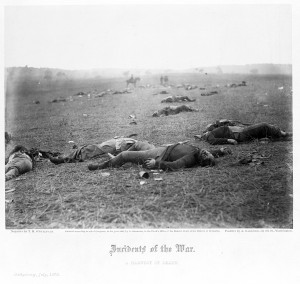
harvest of death
There is another article by Coates describing his line of thinking at: http://www.gdg.org/Gettysburg%20Magazine/coates.html
In that article, Jerry lists the name and companies of the 13 soldiers of the 5th New Jersey that were killed on the second day at Gettysburg. I’m reordering that list here by company.
Lt. Henry R. Clark, Company A
Pvt. Patrick Tynan, Company A
Pvt. Samuel W. Bradford, Company A
Cpl. Edgar S. Van Winkle, Company B
Pvt. Ananias Lynn, Company B
Pvt. John Ryan, Company C
Pvt. Heinrich Troch, Company E
First Sgt. Theodore Sutphin, Company F
Pvt. John 0. Heath, Company G
Pvt. John H. Johnson, Company H
Pvt. Samuel Hasselman, Company H
Lt. Thomas Kelly, Company I
Pvt. Edward Martin, Company I
Pvt. John Ensch, Company K
Regiments in the Civil War were deployed in lines with soldiers touching shoulders with each other. This is normally estimated as a spacing of about 28 inches frontage per soldier. The usual deployment of a regiment was 2 lines. In this battle, the 5th New Jersey deployed as a single line to cover all the ground they were assigned. Apparently the left end was turned back or in military parlance, refused. With 206 enlisted men and about 28 inches per soldier, they should have covered about 160 yards of frontage (28/36 x 206 = 160). That would be an average of 16 yards or 48 feet per company. The 10 companies of a regiment normally deployed with Company A on the right, proceeding to Company K on the left. There is no Company J in the 5th New Jersey. There is no evidence that the 5th New Jersey would have deviated from this standard deployment of companies at Gettysburg.
If we assume killed in action died close to where they were hit and have not been moved prior to the photo, there should be a distribution of bodies similar to this chart. Company A, being closer to the Camera, and Company K being in the distance.
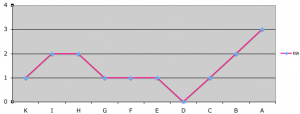
KIA per company
According to Coates theory, this “Harvest of Death” photo looks southward from near the Spangler farm, along the line of the 5th New Jersey.
So we are probably looking down the line of battle, starting at company A, then B and so on. Note how the distribution of bodies in the image is similar to the distribution of killed in the various companies. A bunch of bodies are near the camera, where companies A and B suffered the most KIA of the regiment. Then there is a relative lack of bodies where the center companies were in line. It is hard to make out the distant bodies clearly, but it is possible that there are more bodies there, than in the center of the line. Also, you can see the debris that shows where the left of the regiment was refused.
I do have a question though. It just doesn’t seem like the line extends for 160 yards in this image. Is this due to a telephoto type lens fore-shortening the image, or was the line of the 5th New Jersey shorter than simple math would expect? If the characteristics of O’Sullivans camera lens is investigated, maybe the answer could be provided.
If all the assumptions are correct, then the nearest bodies are those of company A, B and possibly C. If you use your imagination, no men are visible where company D was positioned and the single KIA of companies E, F and possibly G alone in the mid-distance. Could they be the bodies of Pvt. Heinrich Troch (company E), First Sgt. Theodore Sutphin (company F) and Pvt. John 0. Heath (company G)?
Since we know the dead in each of these companies, a person could try to find carte de visites of the slain soldiers of companies A, B and C, and possibly try to identify those bodies.
If all these assumptions are true, it also indicates that KIA in the Civil War, means just that. Soldiers killed in action would have died very close to where they were hit. Though the image is only sharp in the foreground, I can be reasonably sure that 8 bodies are in view. It appears that several more might be in the haze in the background, others buried already, and one unfortunate soldier might be barely showing on the left side of the image. It could be that almost all 14 of the KIA of the 5th New Jersey are in this photo. If any Confederates were killed in this area, they would have been buried before the photo was taken, while the Confederates still occupied this ground.
Also keep in mind that the 5th New Jersey suffered 60 wounded soldiers during the battle, most of whom were probably wounded at this location. It is sobering to to think of the horror that the men of this regiment experienced, during this engagement.

